Debt Ceiling Held Hostage

For the U.S., achieving healthy economic growth and reducing the massive expenditures in the fields that only serve to maintain its global hegemony are certainly the most important way to alleviate the debt ceiling crisis.
One block away from Times Square in Manhattan, New York City, is the famous National Debt Clock, a billboard-sized digital counter that shows the U.S. gross national debt and each American family’s share in real time. Since it was installed on February 20, 1989, the debt displayed on the screen has soared from $2.7 trillion at that time to $31.7 trillion today, equivalent to 124 percent of America’s GDP.
The U.S. federal debt ceiling has been a recent focus in the United States, and the world at large. On January 19, the U.S. national debt had reached the statutory limit of $31.4 trillion. In order to prevent government shutdown and debt default, the Treasury Department subsequently adopted “extraordinary measures.” In a letter to congressional leaders on May 15, Treasury Secretary Janet Yellen reiterated that the Treasury would be unable to continue to satisfy all of the government’s obligations by early June if Congress does not raise or suspend the debt limit before that time.
Between 1917, when the debt ceiling system was first established, and 2012, Congress had raised the upper limit over 100 times. The increases were consistent with economic and social development, and there had been little controversy. However, from then on, the issue has become a bargaining tool between the two major political parties. The direct cause of the crisis this time is that Republicans, who control the House of Representatives, hope to use the debt ceiling uplift to force President Joe Biden to slash government spending, a move that violates the Democrats’ 2020 campaign promises; and Democrats now need to consider how many concessions they can make while minimizing their loss of votes.
This is a dangerous game of brinkmanship. But since neither party wants to actually trigger an economic crisis and become the target of public criticism, raising the national debt ceiling at the last minute, as before, is still their preferred option. The real problem is that the huge accumulated debt has led to an increase in interest burden, posing a severe threat to the health of the U.S. economy. The annual interest expense on U.S. national debt has soared from $528 billion in 2020 to over $800 billion in 2023.

“If you gave your child a credit card and they kept hitting the limit, you wouldn’t just keep increasing it. You would sit down with them to identify where they are overspending and where they can change their behavior,” tweeted U.S. House Speaker Kevin McCarthy on January 18. “It’s time for the federal government to do the same thing.” Although many do not buy this metaphor, and Republicans have not come up with an effective plan that can actually reduce the fiscal deficit, for the U.S., if economic growth slows down, simply raising the ceiling is not a sustainable method to deal with the debt ceiling crisis.
In the context of the global economic downturn, almost all major economies in the world are facing financial constraints, but the debt limit crisis in the United States is even more worrying: U.S. treasury bonds have long been regarded as one of the safest and most liquid assets in the global financial market. This stems from America’s status as the largest economy on the planet and the fact that the U.S. dollar is the world’s principal reserve currency. Other economies currently hold about $7.4 trillion in U.S. treasury bonds—24 percent of total U.S. debt. If the U.S. defaults on its national debt, it will not only affect the U.S. economy, but will also inevitably lead to turmoil in the global financial market. Few countries can stand alone.
For the U.S., achieving healthy economic growth and reducing the massive expenditures in the fields that only serve to maintain its global hegemony are certainly the most important way to alleviate the debt ceiling crisis. On the other hand, the sustained development of the world economy, especially emerging market countries where advanced American products and technologies are in urgent need, will in turn benefit the U.S. If Washington continues its decoupling and deglobalization policies, and at the same time uses the hegemony of the dollar to transfer its economic risks to other countries and regions, a real financial crisis for the country will not be far away. Sooner or later, the bill will come due.
 Facebook
Facebook
 Twitter
Twitter
 Linkedin
Linkedin
 Google +
Google +










